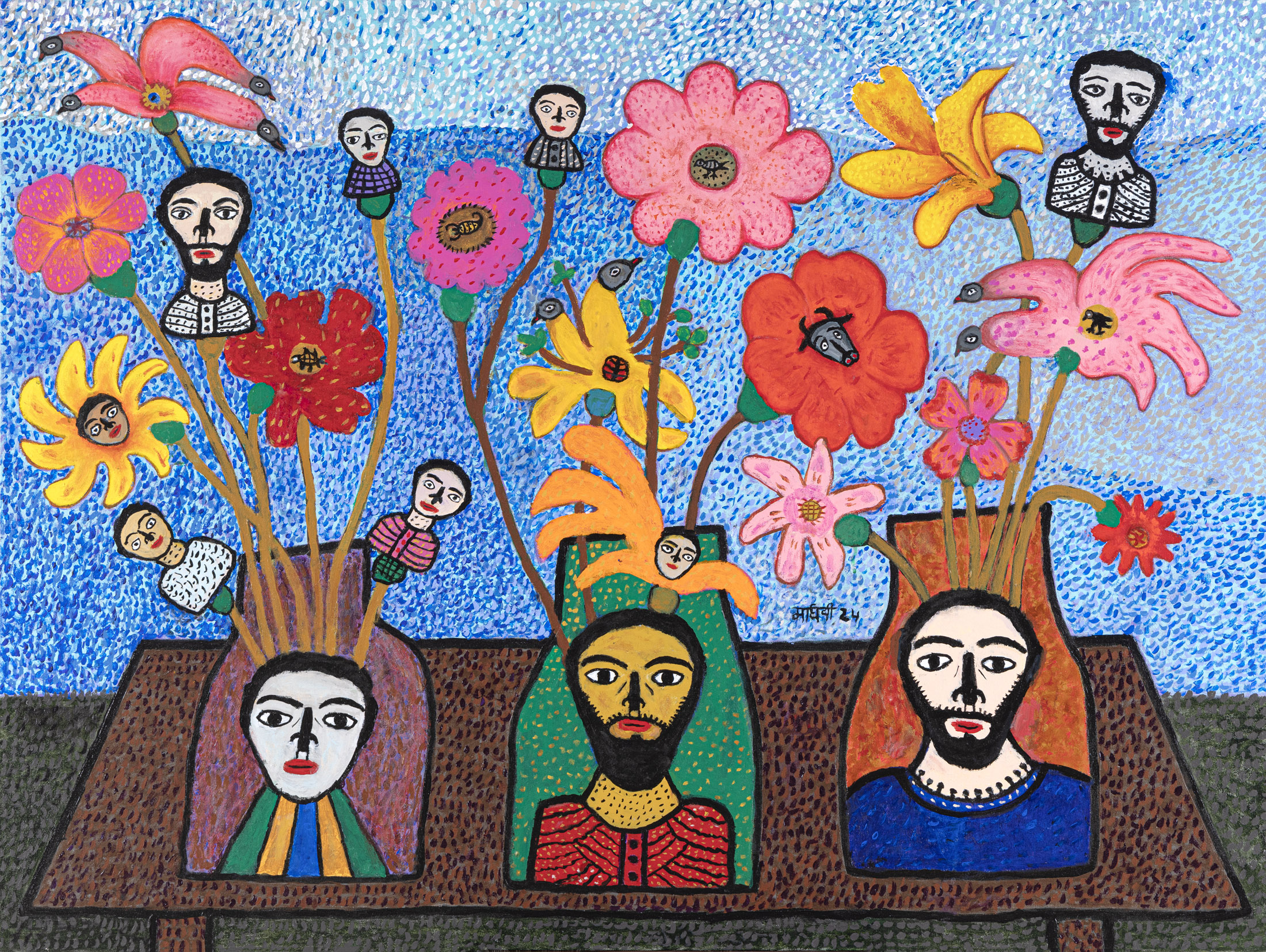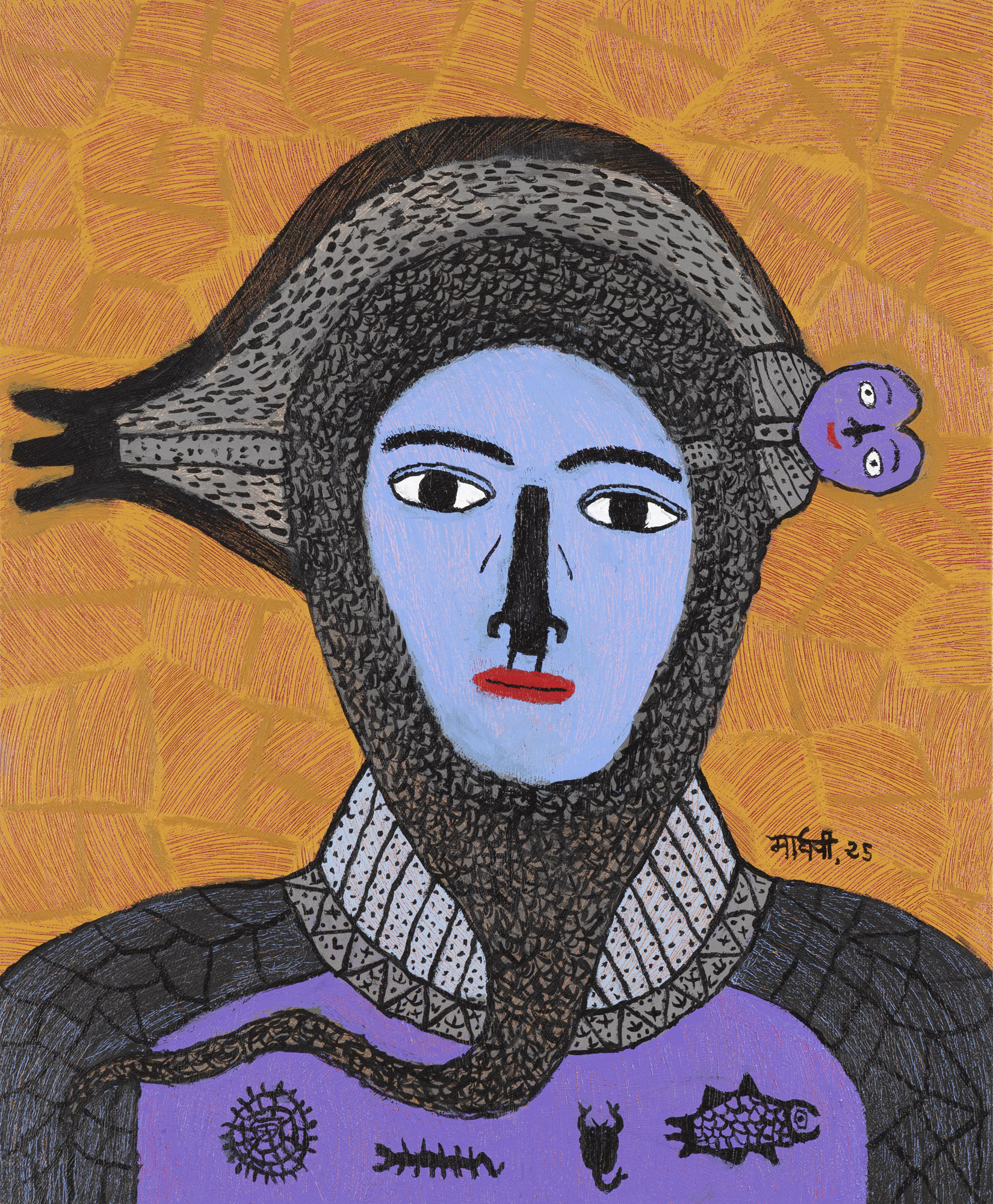Madhvi Parekh’s fantastical tales and transformative journeys
At 83, Madhvi Parekh shows no signs of slowing. Her ongoing exhibition, ‘Madhvi Parekh: Remembered Tales’, at the DAG, New Delhi, reaffirms her status as one of the country’s significant artists. The show, on till August 23, displays her magic with bright colours and deep shades, her free expanse in engaging multi-layered themes and her ‘cool quotient’ in mixing eras as time lapse. Her dots, chevrons, little flowers, circles, crosses and other patterns assemble with rigour and cast a spell on you. There is no ageing for Madhvi in art.
For several decades, she played her role as the wife of Manu Parekh, the successful Modernist, and mother of two daughters, negotiating the ordinary yet necessary struggles of the cities she and her family lived in — Kolkata, Mumbai and New Delhi. In between the banality of household chores, she sketched mythical figures, the charmed life of her childhood village of Sanjaya in Gujarat, visualised silent conversations between humans and animals, and emerged as a confident voice telling her own stories. The show’s title is tied to the stories her sketchbooks have gathered. With pencil and crayons, she wades through everyday life — shopping lists, phone numbers, notes to her husband — along with remarkable creatures and wondrous compositions. ‘Remembered Tales’ takes us on a journey to Madhvi’s heart and mind, presented through her fantastical landscapes and anthropomorphic creatures.
Often folksy, at times feminist, Madhvi’s art is rooted both in the past and the present. Her village appears idyllic, not just because of its simplicity, or the memory of her doting father, but also due to the close bonds humans share with animals. She carries the sights and sounds everywhere and on her canvas, some parts are scattered in the blur of city life. “I spent some wonderful childhood years in my village.” The memory stays, as a muse and motif.
 ‘Flower Vase in My Family’
‘Flower Vase in My Family’
Though her husband both inspired and guided her in the initial years, Madhvi is self-taught. Brief travels abroad and fellowships (to France and USA) exposed her to world masters and diverse art forms. But her not being trained in art has proved to be an advantage as it gives her a certain kind of liberation from forms and techniques.
As a woman and an artist, drawing is a dialogue with herself and the world around. “I kept drawing, and kept learning,” says the rather shy and soft-spoken artist.
In her art, the village lives along with the city. Her triptych, ‘Travelling Circus in My Village’, and another large canvas, ‘Two Scarecrow in My Rice Field’, tell stories in fantasy form. Several beasts and birds fuse to form new species that appear like creatures in a circus. Though Madhvi is drawing from her memory of the village circus, she also appears to be evoking the tamasha-like world of the cities. Looking at her canvas, one understands how much of a circus we are in ourselves. In another canvas, the scarecrows are filled with miniature figures, attractive and engaging, informing of our deep connections with nature. Many of Madhvi’s canvases capture the slow life of the village but shake you with the realisation of how fast so much has disappeared — entertainers like behrupiyas, the ponds and trees that circled many homes, the traditional ‘Ram-Leela’, where men played women characters.
 ‘Fisherman’
‘Fisherman’
Madhvi’s works are now housed in several museums of repute, including the Metropolitan Museum of Modern Art in New York. In recent times, she has received a lot of appreciation for her large dramatic compositions and the effortless ease in placing the female form at the centre. However, it is her portraits at the exhibition, like that of a fisherman, a family, a man with a tattoo, that display her skill to see beyond faces and people. Take the ‘Fisherman’, whose struggle shows on his face, his survival connected to the beings of the ocean as a serpent coils around his head and even morphs into a stingray. It is the portrait of a hardworking labourer, a person of stoical grace and dignity.
While her early works were inspired by masters like Paul Klee, Joan Miro and Henri Matisse, Madhvi’s independent pictorial vocabulary has grown with time. The various notebooks and sketchbooks on display give a rare peep into her evolution. Here you see how beasts grow heads at both ends of their bodies, how men transform into messianic figures and women into fierce deities, how landscapes and eras merge…
For Madhvi, this show is another beginning in her life-long journey of art.
— The writer is a Delhi-based contributor
Arts